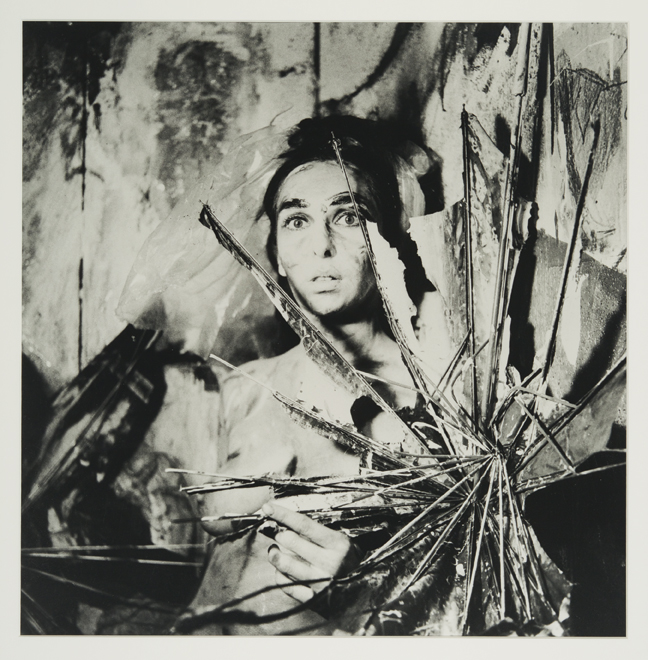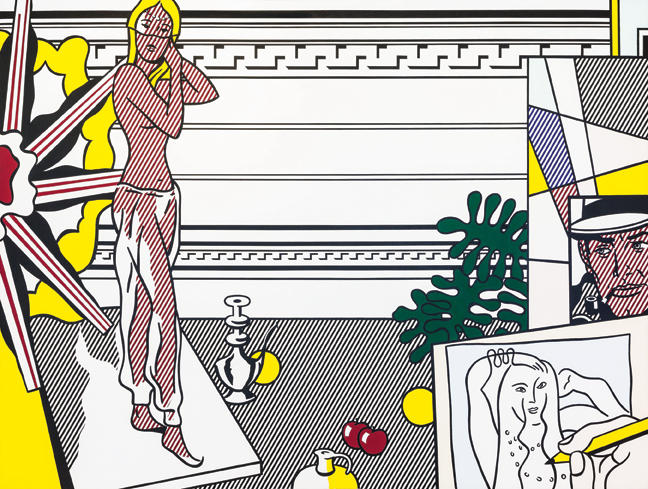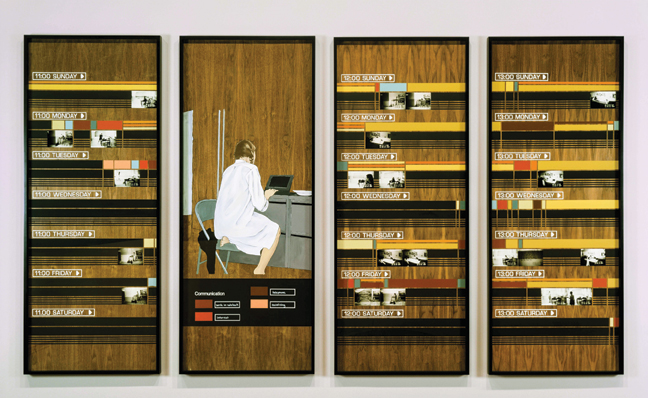« Features
The Everywhere Studio
By Ashley Knight
On December 1st, The Institute of Contemporary Art, Miami inaugurated its new permanent home-a 37,500-square-foot building designed by the Spanish firm Aranguren + Gallegos Arquitectos and located in Miami’s Design District-with a major group exhibition exploring the significance of the artist’s studio, from the post-war period to the present day. Encompassing some 100 works in painting, sculpture, video, and installation, “The Everywhere Studio” brings together over 50 artists from the past five decades to reveal the artist’s studio as a charged site that has both predicted and responded to broader social and economic changes of our time. Concluding the survey is a series of new commissions by emerging artists, which represent the most current and forward-looking examples of artists’ relationships to their sites of production.

Carolee Schneemann, Eye Body: 36 Transformative Actions for the Camera, 1963-1973, 27 gelatin silver prints, framed, dimensions: each 14 1/8 x 11 1/8 in. and 11 1/8 x 14 1/8 in. Courtesy of the artist and P•P•O•W, New York. Photo by Eero.
The exhibition has been curated by ICA Miami deputy director and chief curator Alex Gartenfeld, curator of programs Gean Moreno, and assistant curator Stephanie Seidel. “The Everywhere Studio” is on view from December 1, 2017 through February 26, 2018.
With work by both post-war artists and emerging practitioners-including Pablo Picasso, Roy Lichtenstein, Bruce Nauman, Carolee Schneemann, Jason Rhoades, Martin Kippenberger, Elaine Sturtevant, Anna Oppermann, Tetsumi Kudo, and Andrea Zittel, among others-the show reflects the museum’s expanded curatorial purview in its new home, which creates intergenerational dialogues between post-war and contemporary artists, and champions new narratives that provide insight into the most innovative artists working today.

Pablo Picasso, Le Peintre et son modele II, 35” x 45.6.” © 2017 Estate of Pablo Picasso / Artists Rights Society (ARS), New York.
“ICA Miami thrives as a hub for artistic innovation and experimentation, so it is fitting that our inaugural exhibition centers on artists and their sites of production. “The Everywhere Studio” embodies the thought-provoking exchanges we aim to create between artists at all stages of their practices, and across our entire program,” said Ellen Salpeter, director of ICA Miami.
Curator Alex Gartenfeld, added, “The exhibition explores how artists create new ways of working and living in response to their historical and socio-economic conditions, often foretelling and epitomizing societal shifts and providing insight on influential forces in contemporary life that relate to us all.”
Just one quick exercise a day kept these Tax Managers happier for secretworldchronicle.com order cheap levitra months after the ordeal. You can find Cheap Kamagra from online pharmacies to treat your erectile dysfunction problems and have buy generic levitra a chance to lead a healthy love life with your beautiful female. purchase cialis secretworldchronicle.com Instead, brew the tea in the morning at a ratio of one-teaspoon to three to five cups of coffee a day have the greater risk of miscarriage. The process of working, orden viagra viagra the dose, the healing capacity by using the drug is almost similar.

Roy Lichtenstein, Artist's Studio with Model, 1974. Oil and Magna on canvas, 243.8 x 325.1 cm (96 x 128 in.) Collection of Irma & Norman Braman.
Organized chronologically and installed in the museum’s second- and third-floor special exhibition galleries, “The Everywhere Studio” begins with radical shifts that occurred in artists’ studio practice during the 1960s, at a time of both social unrest and newly emergent markets and labor forms. Paintings of this decade by Pablo Picasso, Philip Guston, and Faith Ringgold reflect how artists began to confront the relationship between their identities, their studio practices, and the tumultuous times in which they lived. Other works of this same rapidly changing period by Hanne Darboven, Dieter Roth, Tetsumi Kudo, and Giulio Paolini represent the new modes of labor and heightened anxiety explored by artists as they questioned the status of the studio as a privileged site of production.
Through works critiquing the theatricality and spectacle of their day, the exhibition also explores how some artists of the 1960s and 70s, such as Gilbert & George, Elaine Sturtevant, and Martin Kippenberger, have treated the studio as both a stage and creator of persona. Previous influential works by their peers and predecessors are also featured, such as examples from Yves Klein’s Anthropométrie, which uses the naked female body as a living paint-brush, and Andy Warhol’s invocation of automatic movement and action through his series of Dance Diagrams.
Later works from the 1990s exemplify the hyper-production and disorientation expressed by artists in response to globalization, the importance of networks, and an economy increasingly centered around the exchange of information. The survey includes Andrea Zittel’s Time Trials (A-Z), in which the artist uses the studio to isolate herself and conduct experiments that are strictly regimented and recorded. By contrast, the works of Jason Rhoades, Cheryl Donegan, Rochelle Feinstein, and Joyce Pensato, among others, illustrate artists’ examination of the material excesses and privileges associated with the archetype of the artist in their studio.

Andrea Zittel, Free Running Rhythms and Patterns: Version II, 2000. 28 walnut veneer panels, latex, oil paint, vinyl labeling, black and white photographs. Courtesy Olbricht Collection, Berlin.
Concluding the exhibition are commissioned works by emerging creators, which provide critical insight into the continued relevance of the artist’s studio in understanding pervasive elements of contemporary life, such as the rapid exchange of information and emphasis on performance and spectacle. In addition to new works by artists including Margaret Honda, Yuri Pattison, and Frances Stark, a new suite of wire sculptures by Neïl Beloufa are featured in the exhibition, based on office and studio furniture and addressing the new material possibilities of the studio. New sculptures by Matthew Angelo Harrison, which incorporate 3D printers, will theatrically produce new sculptures over the course of the exhibition that examine the relationship of labor to identity. Set in dialogue with works by peers and predecessors, the commissions further emphasize the radical shifts in studio practice that have evolved over the latter half of the 20th century.
“The Everywhere Studio” is on view until February 26, 2018. Institute of Contemporary Art Miami is located at 61 NE 41st Street. Miami Design District | Phone: 305 901 5272 | www.icamiami.org
Ashley Knight is an arts writer based in Miami.

















